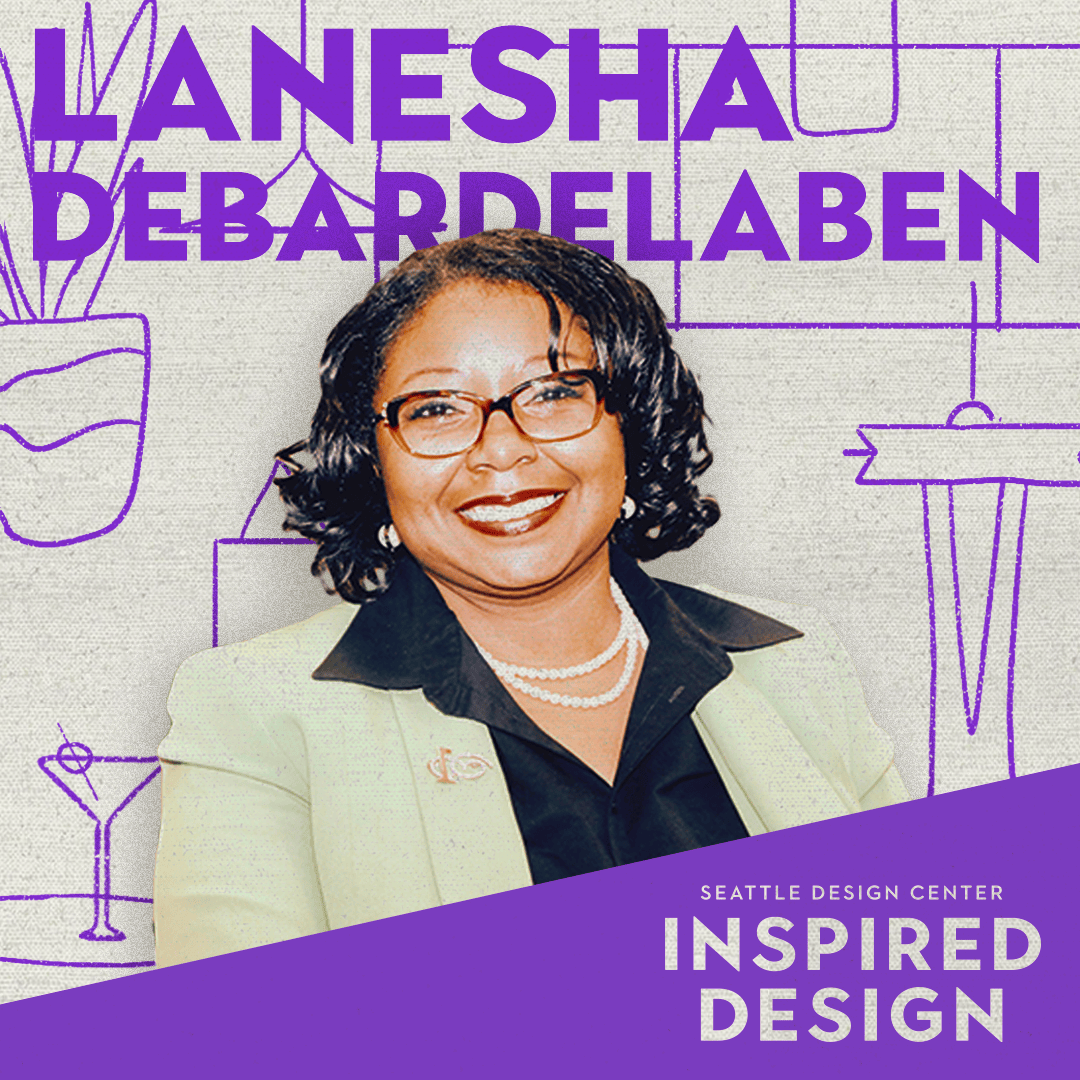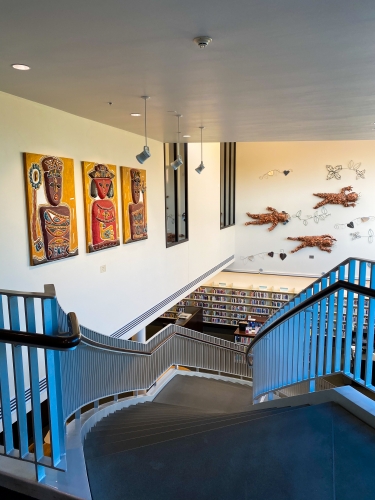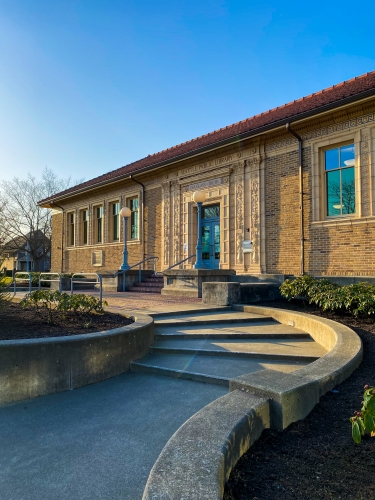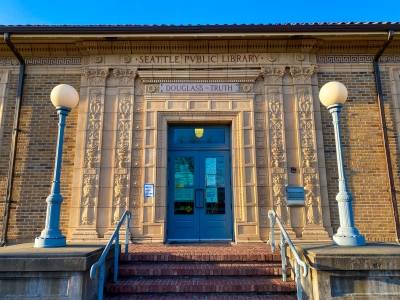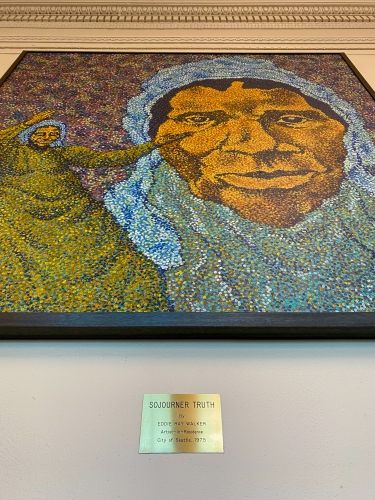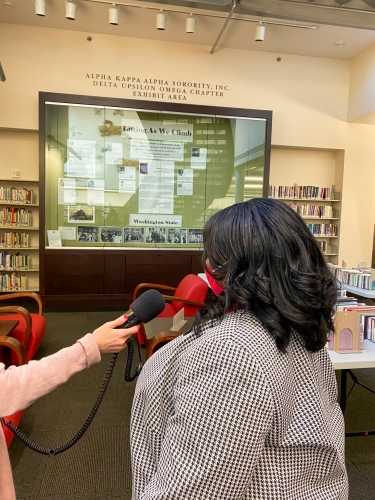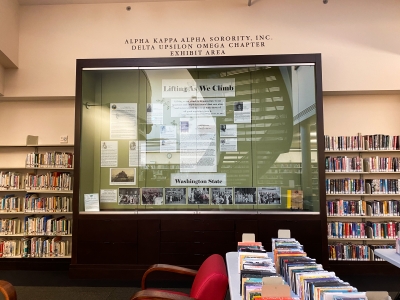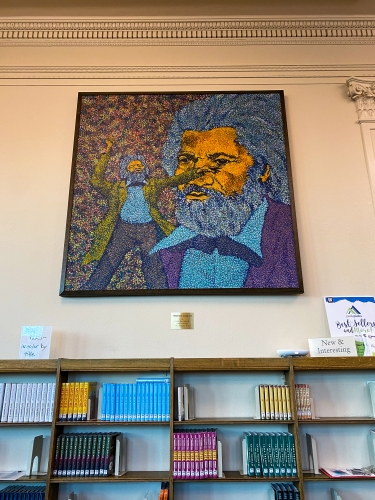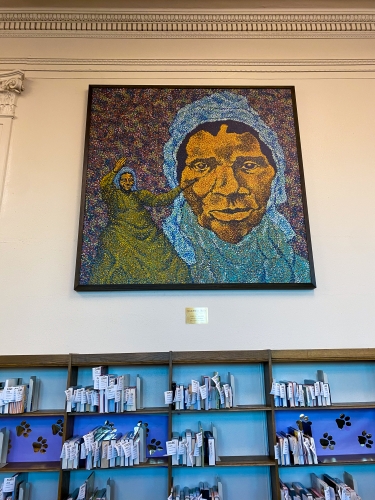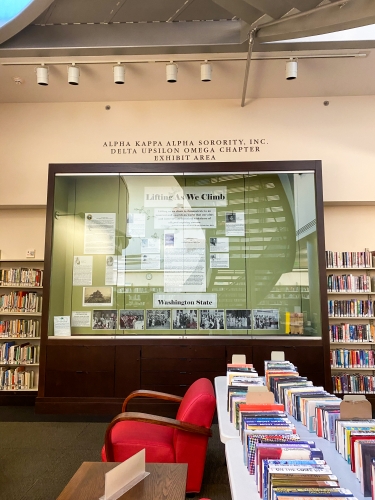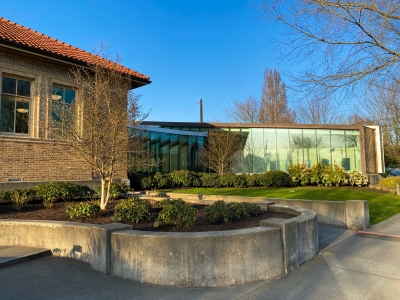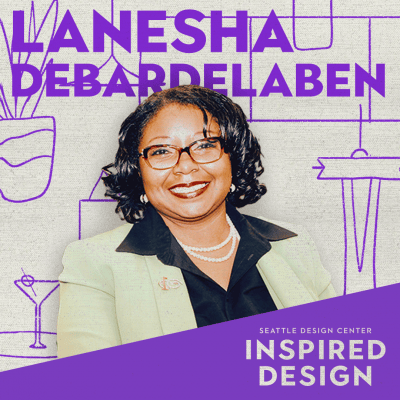
In this episode of Inspired Design, LaNesha DeBardelaben, President and CEO of Northwest African American Museum (NAAM) meets us at her place of inspiration, the Douglass-Truth branch of the Seattle Library. LaNesha will reveal her historical twin and help you find yours while taking you on a soulful journey that transcends time and space.
Statement by LaNesha in response to Gov. Inslee Signing Legislation to Make Juneteenth a Legal State Holiday In Washington
“The passage of legislation to make Juneteenth a legal, statewide holiday establishes Washington as a national leader in acknowledging, educating, and celebrating a more inclusive American history. As an institution dedicated to spreading knowledge, understanding, and enjoyment of the histories, arts, and cultures of African Americans in the Northwest, NAAM was proud to work with Inspire Washington on the advocacy of this legislation and to champion its passage, as noted in the Crosscut op ed here. Juneteenth is an important part of our history and culture — not Black history, but American history. Inclusive recognition and anti-racist education are essential in building understanding and paving the way toward a more just society. This June 19, NAAM will honor Juneteenth by collaborating with nine other African American museums across the country to host a virtual celebration that people can join from anywhere in the world. For the local community, we will also host an outdoor Jubilee Day Jamboree in Seattle.”
Episode Transcript
Speaker 1:
This is my favorite spot in Seattle. Besides the Northwest African American Museum this is the space and place that gives me so much joy and serenity and calm. And it’s a space for reflection and perfection.
Gina Colucci:
I’m Gina Colucci with the Seattle Design Center. Every week on Inspired Design we sit down with an iconic creator in a space that inspires them. Today I’m speaking with LaNesha DeBardelaben, President and CEO of the Northwest African American Museum. She came to Seattle from Detroit, where she was the senior vice president at the Charles H. Wright Museum of African American History. She has global experience with museums and libraries in Kenya, Ghana, South Africa, England, Germany, and Israel, and is involved in both the International Council of Museums and the International Women’s Forum. That’s why I was a little surprised when LaNesha suggested the Douglass-Truth Branch of the Seattle Public Library as the inspiring location of our conversation.
LaNesha DeBardelaben:
I have been drawn to libraries ever since I was a little girl. I was reserved, I was an introvert, and libraries naturally were spaces where I just felt comfortable. I felt like I could be myself, and I’ve always been curious about history and about culture, and libraries are places that are full of knowledge and information about history and culture.
Gina Colucci:
I learned how museums and libraries are intertwined in LaNesha’s personal and professional life, and in our society as a whole.
LaNesha DeBardelaben:
I fell in love with the inner workings, the inner feel the energy of the library. As soon as you walk in, you are faced with these beautiful portraits of Sojourner Truth and Frederick Douglas. And again, these are individuals that I’ve been studying since a little girl, going to the library spending every day after school reading about black history. And the Douglass-Truth library is an institution that houses the largest African American historical and literary collection in the West Coast. That is so impressive. That’s a point of pride, and that drew me here as well. So there are just so many aspects about the Douglass-Truth Library that literally made it, like my second home, just like when I was a little girl, the library was always my second home and here in Seattle this is like my second home. We are right in the heart of the city at 23rd and Yesler.
Gina Colucci:
The library extends beyond the walls of the building itself. It has strong roots in the central district.
LaNesha DeBardelaben:
In the 1940s and ’50s, and definitely by the ’60s, the central district was a predominantly African American community and the residents of the city at that time ensured that this library would reflect the African American rich literary and artistic traditions. And so we are graced, these walls are graced with the artwork of brilliant artists of color. If you look behind you, that artwork on the wall, that’s the work of an award winning local black woman artist, Marita Dingus. And the two portraits of Sojourner Truth and Frederick Douglas were done by a local artist, Eddie Ray Walker, and the other artwork that adorns these walls, they reflect the rich cultural diversity that has always been found in the central district. And so it just enriches the soul to be in this space.
LaNesha DeBardelaben:
Like it’s not just the books that are on the shelf here that enrich us. It’s the artwork. It’s the rooms that are in this library, named after important trailblazing African American men and women and families of this community, pioneers like the Gayton Family Meeting Room, the Gayton family is just an influential African American family, who they were pioneers here. They’ve been here since the 1880s. And then we have the Louise McKinney reading room named after the former first lady of Mount Sinai Baptist church, the first Baptist African-American congregation founded in 1890 here in Seattle. So we learned so much about African American history, about Seattle and about ourselves at the Douglass-Truth Library.
Gina Colucci:
Because LaNesha so firmly believes in the connection between history and each person’s story, I wanted to ask about her story and how museums became her profession and her calling?
LaNesha DeBardelaben:
The interesting thing is that I grew up in poverty in a small town in Saginaw, Michigan, two hours north of Detroit. And because of the impoverished conditions of my family and community, I did not attend museums until college. My junior year in college was my first real museum experience. So growing up, not only did I not go to museums, because it was across town and there were economic barriers, there was an admission fee. And so that’s why I spent all my time in the public library. And it was not until my going into my junior year in college, I was studying history. I was planning to be a high school history teacher. And I happened upon this internship at a museum and was not aware of career options in museums, because I did not see anybody that looked like me in museums. I did not have full access to museums economically.
LaNesha DeBardelaben:
It was not in my purview at all. That internship experience changed the trajectory of my career entirely. And this was while I was overseas as an exchange student in Nairobi Kenya. And so my first experience was in a black museum, an African museum. And I saw myself all around, because these were people of color who were museum educators and museum administrators and museum curators. And with my passion for history and for education and for literacy, my world changed, because I could bring all of this together, all of my passions together in a career in museums, and I’ve not looked back, that was 28 years ago. And the museum field has truly been a dream come true for me. It doesn’t feel like work. It never feels like work. Because it is surrounding myself with the stories of the past that have always fueled and nourished my soul. And so the work feeds me and strengthens me and is so seamlessly aligned with my purpose, my passion, and my calling. And so there is no other career field for someone who is so drawn to telling and preserving the stories of the past.
Gina Colucci:
That’s amazing. It’s not every day you get to talk to somebody who has that initial, that definite, this is when I was inspired to take this career path. You know, something sparked you and you just ran with it. And it’s really amazing. You kind of mentioned the speaking to your soul, is there a art piece or a exhibit that just split you wide open?
LaNesha DeBardelaben:
Absolutely. You know there is, Gina. It is in Memphis, Tennessee. The National Civil Rights Museum is a historic site. It is the assassination site of Dr. Martin Luther King Jr. It’s where he spent his last night, took his last breath. And in 1991 the site became a museum, a public museum. And since the day they opened, they have been educating through exhibitions on the power of the civil rights movement and the legacy of Dr. King’s life. And in 2014 that museum underwent an extensive multimillion dollar renovation. And shortly thereafter I visited that museum, and it literally brought me to my knees standing in front of room 306, and listening to Mahalia Jackson sing Reverend Dr. Martin Luther King Jr’s favorite hymn, Precious Lord take my hand.
LaNesha DeBardelaben:
(singing)
LaNesha DeBardelaben:
It is the most soul stirring, heart touching, exhibition experience I have ever encountered. And I encourage everybody, if you get a chance to go to Room 306 of the Lorraine Motel, which is now the National Civil Rights Museum in Memphis, Tennessee, your soul will be moved when you hear Mahalia Jackson as you walk toward 306, the hotel room of Dr. King’s assassination site. There is nothing like that museum experience for a visitor.
Gina Colucci:
Just hearing you speak of it gives me chills. You know, having that experience for you and being the president and CEO of the Northwest African American Museum. Do you hope that you can have an impact on somebody like that exhibit had an impact you?
LaNesha DeBardelaben:
Museum exhibitions are spaces where we should leave differently from how we entered the gallery, and exhibitions that help people to have an open mind and a changed heart are exhibitions that are really fulfilling their mission.
Gina Colucci:
And we need that right now. Yes, we do. We talk about a lot of places that inspire people, but is there a person that inspires you?
LaNesha DeBardelaben:
Oh, so many. So let me just think. I believe that we all have a historical twin, someone in the past that we strive to look like, that we strive to emulate their strength, their tenacity, their resolve, their drive. And I believe that if we just reflect on who we are striving to be, we will come to discover and realize who our historical twin is. And my historical twin gives me such inspiration. I think about her daily. Her example keeps me going when I get tired and become a bit weary and become a bit frustrated with the challenges I’m facing. I think about Mary McLeod Bethune and what she faced and how she overcame it. Gives me the strength to face whatever comes my way and to overcome it. So Mary McLeod Bethune was born in 1875 in South Carolina as the 17th of 17 children to formally enslaved parents.
LaNesha DeBardelaben:
And she was the only sibling who was afforded an education and her family entrusted her said, “Mary, you’re the only one that’s going to be able to get this education. So use it to make us all better.” She took that expectation seriously. And she went on to study in college and become an educator. She wanted to be a missionary, but, into Africa, but black women at that time were not allowed to be missionaries in Africa from Moody Bible College, where she was in Chicago. And so she instead went into education and it became her calling. And she started a college with a $1.50 cents and faith. And she established the National Council of Negro Women in 1935. She was an advisor to Franklin Roosevelt, a close friend to Eleanor Roosevelt.
LaNesha DeBardelaben:
And she was one of the most influential black women in politics during one of the most transformative times in African American history during World War II going into the 1950s. Mary McLeod Bethune was an institution builder when African Americans were not allowed to go to the hospital in Daytona Beach, Florida, because they had quotas on the number of African Americans that the mainstream hospital would serve, Mary McLeod Bethune started her own hospital. When African Americans were not allowed to go to the library in Daytona Beach, Florida, Mary McLeod Bethune started her own library. She started her own college. And so she was fearless and she did not let anything stop her. And so I strive to be that kind of institution builder. I strive to carry that kind of determination into the work that I do.
LaNesha DeBardelaben:
I’m striving to look like Mary McLeod Bethune and it is what keeps me going and striving to make a difference the way that she did, because I too am one of the, I’m the first in my immediate family to go to college. And I realized that everything that I do is in service to others to make my family proud the way that Mary McLeod Bethune made hers proud. That same expectation that was on her is on me. And so I’m just grateful that her example gives me a model of leadership and selfless influence that I hope.
Gina Colucci:
You definitely are. Those are big shoes to fill, you are well on your way. As our tour took us to the new edition of the library, you descend down this beautiful staircase. And once at the bottom we rounded the corner and right there is this huge display.
LaNesha DeBardelaben:
This is my absolute favorite space. My heart is swelling with pride right now.
Gina Colucci:
To describe what we were looking at. It’s a floor to ceiling glass case filled with images representing the rich history of black women in Washington State and beyond.
LaNesha DeBardelaben:
We are at the display case of Alpha Kappa Alpha Sorority Delta Upsilon Omega Chapter. This display case tells the story of African Americans in this community, in this city, in this state, through the lens of the oldest black sorority in the country.
Gina Colucci:
It holds personal meaning for LaNesha, an Alpha Kappa Alpha member herself.
LaNesha DeBardelaben:
Yes, yes, yes. This exhibition space is always telling the African American story by African American women of this community. This sorority donated the … At that time, it was called the Negro Collection. It was in 1965 and the Alpha Kappa Alpha Sorority Delta Upsilon Omega Chapter, which is located here in Seattle, comprised of college educated African American women leaders in all kinds of fields and industries. These are all professional women that come together to serve community in a shared sisterhood. And it’s so inspiring to see that they have dedicated since 1965 their financial and volunteer hours to ensure that this display is always adorned with black history, black art and black culture. It is truly an inspiration. This is my absolute favorite spot, because it was in a space like this that drew me to African American history as a small child, as a six-year-old, seven-year-old girl, going to the library, I was drawn to displays like this that allowed me to see myself and see who I could be.
LaNesha DeBardelaben:
And here we are looking into this display case and seeing women like Ida B. Wells, Nannie Helen Burroughs, Anna Julia Cooper, Mary Church Terrell, Sojourner Truth. These women reflect the best of black womanhood. It just almost brings me to tears, because it is what so many of us have dedicated our lives to doing, to preserving this history. So that we can always know who we are, who we can be. And that we are always working on becoming our best self. I encourage individuals to come and to stand in front of this Delta Upsilon Omega Chapter Alpha Kappa Alpha Sorority display case, because there is going to be some historical truth that you need to know, and it’s told here in this display case. And it helps us all to become better, no matter what our gender may be, no matter what our ethnicity may be.
LaNesha DeBardelaben:
These are stories of individuals who overcame odds and we all face hardships and challenges in our lives. All of us, no matter who we are, no matter our age, our ethnicity. And these stories inspire us to find a way to hold on, to get through, to overcome the challenges that we all face in our lives.
Gina Colucci:
As we walked up closer to it, you could see this title.
LaNesha DeBardelaben:
Lifting as We Climb. That was the motto, and that still is the motto of the National Association of Colored Women’s Clubs. This is an organization that was established in 1896 when black women were rejected from joining the National Association of Women’s Clubs. They had to organize themselves and create their own organization so that they could employ their leadership, their commitment to community, pull their resources together to serve their community. And to build a better way for African Americans. And so this model, Lifting as We Climb is a mantra that all of us should live by. We are all climbing, we’re all striving to become better in our personal lives, in our family lives, in our professional lives. As we climb, let’s lift up somebody else. Let’s help somebody else as we help ourselves. These black women have lived by this. They have led by this, and they have died by this.
LaNesha DeBardelaben:
They have spent their lives giving their best as they strive to be their best. It’s a lesson for all of us. Their legacy teaches and instructs us all on how to do what we can when we can, how we can, to improve the life of others. That’s what Lifting as We Climb is all about. This sorority, Alpha Kappa Alpha Sorority is the sorority that our first female vice president is a member of. And she joined the sorority at a historically black college, Howard University. And so we are at a point of transition and redefinition of what kind of country we will be. And we have to lift as we climb in order for us, all of us, to continue on this path of becoming a better country for all, a more equitable country for all.
Gina Colucci:
Hey, if you’re inspired to find your historic twin, head to Instagram and comment on the post for this episode, Inspire Design is brought to you by the Seattle Design Center. The show is produced by Larj Media. You can find them at larjmedia.com. Special, thanks to Michi Suzuki, Lisa Willis, and Kimmy Design for bringing this podcast to life. For more, head to seattledesigncenter.com, where you can subscribe to our newsletter and follow us on social media. On the next episode of Inspired Design, Linda Derschang gives us all the juicy behind the scenes details about Linda’s Tavern and her layer design process.
Speaker 1:
All right so can you please find an avocado green, a pink, purple, some kind of colored sync. And I just think that sync is fantastic.


